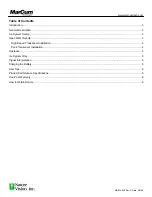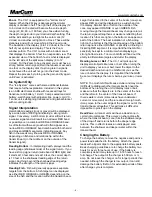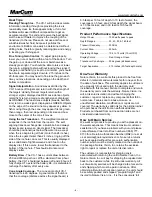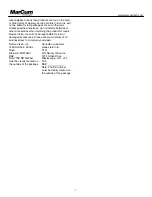
www.marcumtech.com
- 4 -
edge mounted against the transom. The leading edge of
the transducer should be mounted flush with bottom of
the boat. This can be best achieved by using a flat object
like a ruler and holding it flat along the bottom of the boat
and matching the bottom of the transducer to the bottom
of the boat. Attach the mounting hardware to the high-
speed transducer as shown in the instructions included
with the transducer. Hold the transducer, with attached
mounting hardware, to the transom of the boat (flush to
the bottom) and mark the center of the holes on the
transom. Drill the appropriate-size holes and attach the
transducer to the transom. Tilt the rear of the transducer
between 2 and 5 degrees below the transom to ensure
solid contact with the water when the boat is on plane. It
may be helpful to use a small amount of marine silicone
along the leading edge of the transducer filling in any
gap between the transducer and hull. This will help
eliminate any white water or air bubbles, which can
cause random interference on the sonar display.
Use caution in applying silicone to ensure that it only
comes in contact with the leading edge of transducer,
and does not smear across the face of transducer
resulting in reduced sensitivity. More-detailed installation
instructions are included with the high-speed transducer
and mounting hardware.
Puck Transducer Installation
Puck-style transducers can be mounted on the bottom of
a trolling motor, epoxied in the hull of a fiberglass boat,
or mounted to a suction cup for portable use. Mounting
to a trolling motor is achieved with the use of a large,
adjustable stainless steel hose clamp available at most
hardware or automotive stores. Slots are included in the
puck transducer for passing the clamp through and then
around the motor. Align the transducer so that it is
perfectly centered from right to left on the bottom of the
motor. If the transducer is tilted or angled, you won’t
receive a signal on your sonar display. Do not mount the
transducer next to the propeller. Turbulence from the
propeller may cause disruption in the sonar display. In-
hull mounting is designed for achieving high-speed
sonar readings in fiberglass boats. For the best
readings, the transducer must be mounted in the layer of
fiberglass that is in direct contact with the water. This is
best achieved by mounting the transducer in the area
surrounding the bilge pump in the transom area of the
boat. Some boats have false bottoms or floors. Mounting
the transducer in a location not in direct contact with the
water will result in dead air space and no sonar reading.
Once the correct area is located, the transducer is
installed using a good grade of marine epoxy. For more-
detailed installation information, refer to the directions
included with the puck transducer.
Operation
The VX-1 utilizes a combination of control knobs (Gain &
Range) and keypad (IR) and (ZM) to change or activate
various system functions. The keypad has an audible
beep when the key is depressed to indicate that a
system function has been activated. The following is an
explanation of the various system functions.
Range Select
- The Range select knob is used for
turning the VX-1 on or off, as well as choosing the
correct depth range. The VX-1 offers four depth ranges
to choose from that can be selected by rotating the knob
clockwise. The depth ranges are 20, 40, 80, or 160 feet.
The depth-range setting is determined by turning the unit
on and turning the Gain knob looking for a solid return
(band of light) indicating bottom on the display. If no
return is present, then select the 40-, 80-, or 160-foot
range until a bottom reading is displayed on the screen.
Gain Knob
- The Gain knob controls the amount of
sensitivity required by the unit to pick up objects like
bottom, weeds, fish, smaller bait-fish, or small lures and
jigs. The lower the number, the less sensitivity,
conversely higher numbers mean more sensitivity.
However, too much Gain (sensitivity) will result in too
much information being displayed, and it becomes
difficult to interpret the return signals. The best Gain
setting is achieved by turning up your Gain from 0 until
you receive a clear and steady bottom reading. If you’re
looking for your lure or bait, turn up the gain until you just
begin to display your bait without it fading or flickering on
the screen. The lower the sensitivity, the narrower the
display segments, the easier it is to distinguish targets.
We cannot emphasize this strongly enough. Too much
Gain will only clutter the display with unnecessary
information, making it more difficult to interpret the return
signals. Keeping the Gain at minimum levels will actually
provide you with the most accurate and precise
information.
Interference Rejection
- The Signal Interference
Rejection system is designed to knock out competing
return signals from other sonar units being used within
close proximity. When other sonar units are causing
interference to the display of the VX-1, activate the IR
feature by depressing the IR key located on the face of
the VX-1.
There are 12 levels of interference rejection that can be
used to knock out competing signals. Press the IR key to
activate, each consecutive actuation (depressing the
key) will change the level of signal rejection. Each
actuation will result in an audible beep informing you that
a system command has been recognized. The correct
level of IR will be achieved when the display is clear of
display clutter. In some extreme cases, clutter will be
greatly reduced but not totally eliminated.








